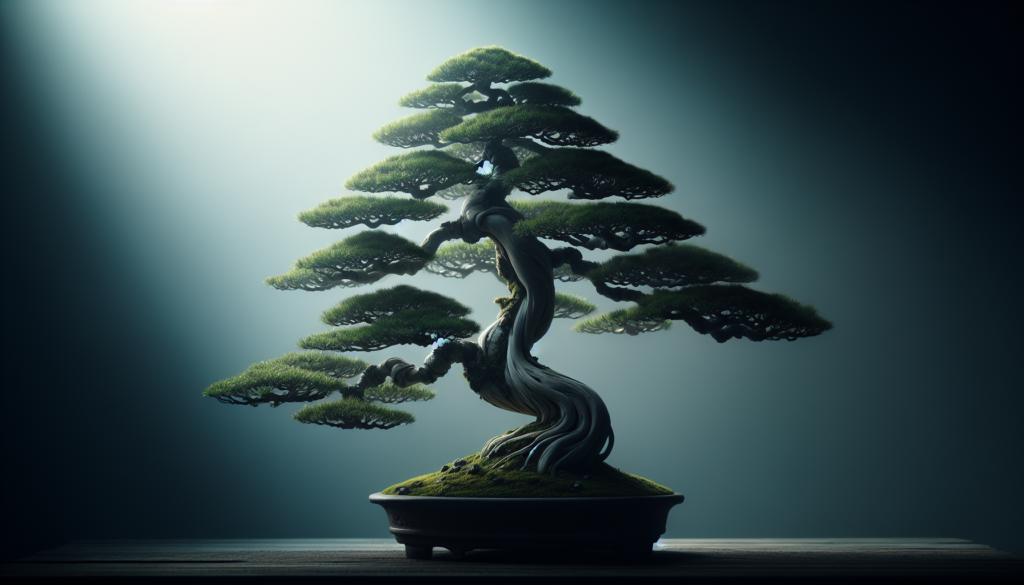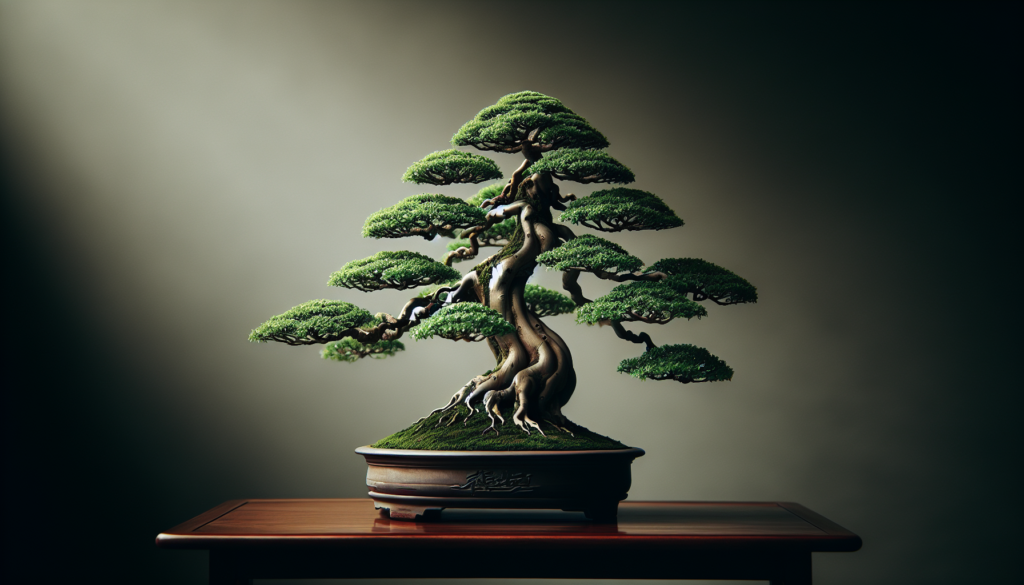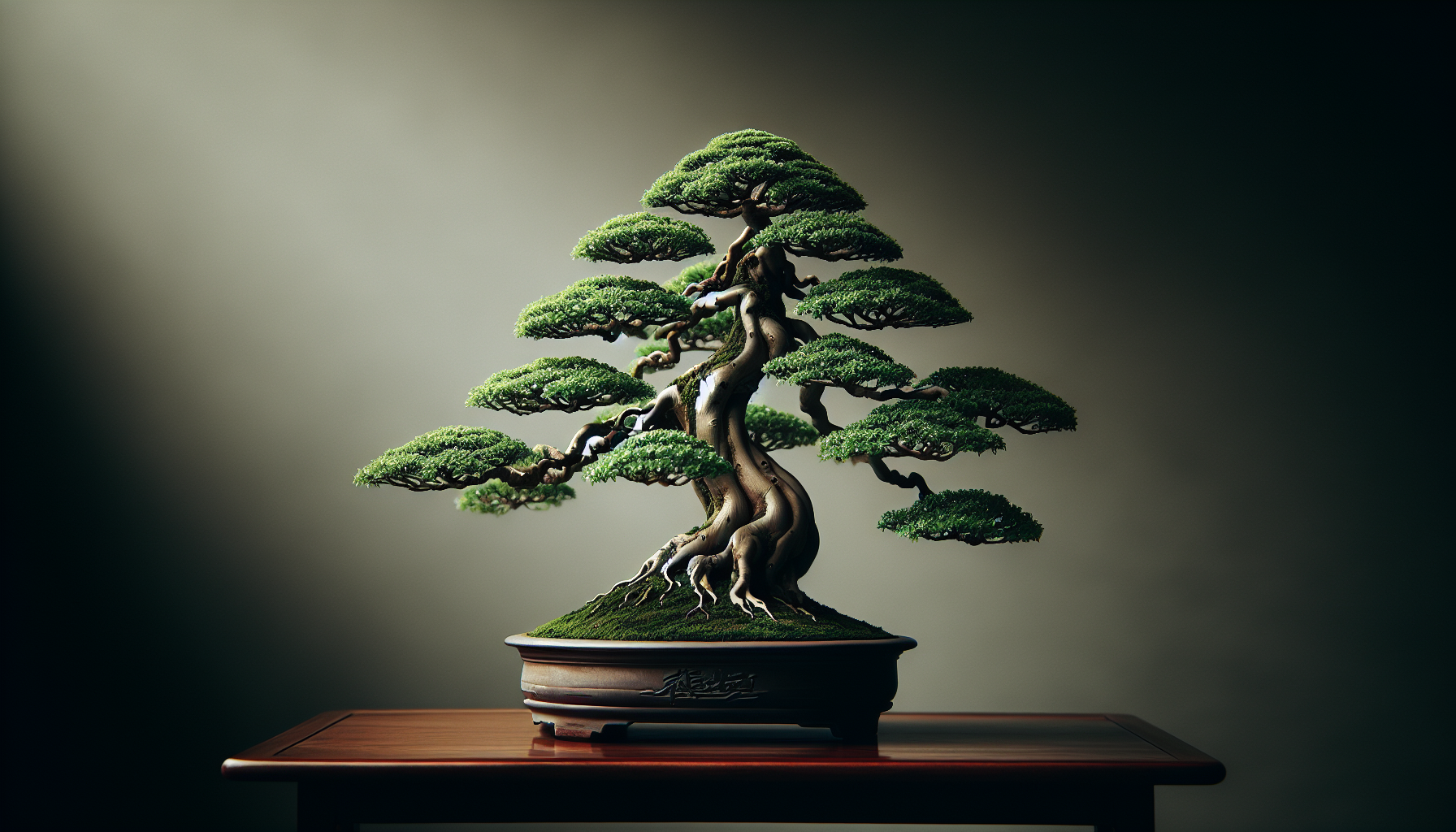Have you ever wondered how something as small and intricate as a bonsai tree can play a significant role in literature? In this fascinating article, we explore the enchanting relationship between bonsai and the world of literature. From symbolizing growth and resilience to representing the human condition, bonsai has captured the hearts and minds of writers throughout history, resulting in its frequent appearance in various literary works. Join us as we uncover the many ways in which bonsai has shaped and influenced the narratives that have touched our lives. Get ready to embark on a literary journey where every leaf of a bonsai tree tells its own unique story.
Understanding Bonsai: An Art and Cultural Asset
Bonsai, originated from the Japanese words bon meaning “tray” and sai meaning “plant”, is a fascinating form of art that involves the cultivation and care of miniature trees in pots. It is a practice that requires attention to detail, patience, and a deep understanding of nature. Bonsai is not just a hobby, but has also become an integral part of various cultures around the world, serving as symbols of harmony, balance, and cultural identity. In this article, we will explore the various aspects of bonsai, its history, symbolism, and its significant presence in literature, art, and popular culture.
Definition of Bonsai
Bonsai, when defined in its simplest terms, refers to the art of growing and training miniature trees in containers. The aim is to create a representation of a larger, older tree in nature, with its characteristic shape, texture, and harmony. Unlike dwarfism, which involves genetic modification, bonsai achieves its miniature size through careful pruning, wiring, and the regulation of growth. It is a careful balance between nature and human intervention, creating a living artwork that captures the essence of nature within a confined space.
History and Evolution of Bonsai
The history of bonsai traces back to ancient China, where it was initially practiced as a way of beautifying gardens. However, it was in Japan that bonsai truly flourished as an art form. The influence of Zen Buddhism in Japan played a significant role in shaping the evolution of bonsai. Zen monks incorporated bonsai into their meditation practices, cultivating a deep appreciation for nature and its harmony. Over time, bonsai spread to other parts of the world, adapting to different cultural practices and techniques. Today, bonsai remains a highly regarded and cherished art form, celebrated for its profound cultural significance.
Bonsai Practices Across Different Cultures
While bonsai has its roots in East Asia, it has been embraced by cultures across the globe. In China, bonsai is known as penjing, which translates to “tray scenery”. Chinese bonsai often includes miniature landscapes, with the trees being just one element in a larger composition. In the Western world, bonsai has gained popularity in recent years, with enthusiasts exploring different styles and species. Each culture brings its unique approach to bonsai, resulting in a diverse range of techniques and aesthetics that make this art form truly captivating.
The Symbolism of Bonsai Trees
Bonsai as Symbols of Harmony and Balance
Bonsai trees are often seen as symbols of harmony and balance in nature. The meticulous care and pruning required to maintain a bonsai tree represent the need for balance in our own lives. Just as a bonsai tree requires the right amount of sunlight, water, and nutrients to thrive, we too must find the balance between work, rest, and personal fulfillment. Bonsai reminds us to appreciate the beauty of simplicity and the need for equilibrium in all aspects of life.
Meaning Attached to Different Types of Bonsai Trees
Each species of tree used in bonsai cultivation carries its own symbolism and meaning. For example, the pine tree, with its evergreen foliage, represents longevity and endurance. The cherry blossom bonsai, with its delicate and ephemeral flowers, symbolizes the transient nature of beauty. Juniper bonsai, with its twisting and contorted trunk, embodies resilience and strength. The variety of trees used in bonsai allows for a rich tapestry of meanings and interpretations, adding depth and significance to the art form.
Bonsai in Zen Buddhism
Zen Buddhism, with its focus on meditation and mindfulness, has a deep connection with bonsai. Zen monks found solace and spiritual growth in the practice of bonsai, viewing it as a way to connect with nature and reflect upon the impermanence of life. Bonsai became a metaphor for the journey of self-discovery, with the careful cultivation of a tree mirroring the cultivation of one’s inner self. This connection between bonsai and Zen Buddhism is still present today, as many practitioners find peace and tranquility through the art of bonsai.

Bonsai in Classic Literature
References to Bonsai in Early Eastern Texts
Bonsai has made appearances in ancient Eastern texts, providing glimpses into its significance throughout history. In Chinese literature, references to penjing can be found in poetry and prose, often depicting the beauty and harmony of nature. In Japanese literature, bonsai is mentioned in classic works such as “The Tale of Genji” and “The Pillow Book.” These references showcase the integration of bonsai into the cultural fabric of these societies, highlighting its long-standing prominence in literature.
Bonsai in Western Literature
As bonsai gained popularity in the Western world, it found its way into literature as well. In Western literature, bonsai is used as a metaphor for various themes and ideas. It represents the pursuit of perfection in Nathaniel Hawthorne’s “The Artist of the Beautiful” and serves as a reflection of the characters’ inner growth in Kazuo Ishiguro’s “An Artist of the Floating World.” Bonsai’s appearance in Western literature underscores its universal appeal and the profound impact it has on artistic expression.
Bonsai in Poetry Across the Centuries
Throughout history, poets have been captivated by the beauty and symbolism of bonsai. From ancient Chinese poets like Li Bai and Du Fu to modern-day haiku masters like Matsuo Basho, references to bonsai can be found in their works. Bonsai serves as a source of inspiration, allowing poets to explore themes of nature, transience, and the human experience. The meditative and contemplative nature of bonsai aligns perfectly with the introspective qualities of poetry, creating a seamless union between these art forms.
Bonsai in Contemporary Literature
Fictional Works Centering Bonsai
In contemporary literature, bonsai often takes center stage as a focal point for storytelling. Writers have utilized the art of bonsai to explore characters’ personal growth, relationships, and the search for meaning in life. Kazuo Ishiguro’s “Never Let Me Go” features a poignant scene with a bonsai tree, symbolizing the fragility and vulnerability of the characters’ existence. In Haruki Murakami’s “Kafka on the Shore,” the presence of a bonsai garden reflects the interconnectedness of the characters’ lives. Bonsai’s inclusion in contemporary literature adds depth and nuance to the narrative, inviting readers to contemplate themes of identity and self-discovery.
The Role of Bonsai Trees in Modern Poetry
Modern poets continue to find inspiration in bonsai, infusing their verses with its profound symbolism. The compact size and elegant form of a bonsai tree offer poets a visual representation of their emotions and ideas. The healing power of nature, the passing of time, and the ever-changing nature of life are just a few themes poets explore through bonsai imagery. Bonsai becomes a vehicle for introspection and self-expression, enabling poets to convey the complexities of the human experience in a concise and impactful manner.
Non-fiction Books about the Cultivation and Care of Bonsai
Bonsai’s popularity has generated a wealth of non-fiction literature dedicated to the art of bonsai cultivation and care. These books serve as valuable resources for bonsai enthusiasts, providing detailed guidance on techniques, species selection, and the art of shaping and maintaining bonsai trees. From comprehensive manuals to beautifully illustrated guides, these books cater to beginners and seasoned practitioners alike. Non-fiction books about bonsai not only educate but also foster a sense of community among bonsai enthusiasts, encouraging the sharing of knowledge and experiences.

Bonsai in Children’s Literature
The Incorporation of Bonsai in Children’s Stories
Children’s literature has embraced the beauty and wonder of bonsai, bringing it to life in enchanting stories. Picture books such as “The Little Tree” by Müslüm Yılmaz and “My Juniper Bonsai” by Gabriele Tröger delight young readers with the tales of miniature trees and the magic they hold. These stories not only introduce children to the aesthetics of bonsai but also impart important lessons about patience, nurturing, and the interconnectedness of all living things.
Lessons Drawn from Bonsai Trees in Children’s Literature
Bonsai serves as a metaphor for growth and resilience in children’s literature, teaching valuable life lessons. Through the journey of a bonsai tree, children learn about the importance of patience, as they witness the slow but steady progress of a tree from seedling to a fully formed miniature tree. Bonsai also teaches children about responsibility and the significance of caring for living things. These lessons encourage empathy, foster a deeper appreciation for nature, and instill a sense of environmental stewardship from an early age.
Popular Children’s Books Featuring Bonsai
Children’s books featuring bonsai have gained popularity in recent years, capturing the imagination of young readers. Books like “Why Evergreens Keep Their Leaves” by Annemarie Riley Guertin and “The Bonsai Tree” by Kathleen V. Kudlinski take children on whimsical journeys inspired by the art of bonsai. These stories engage children’s curiosity and invite them to explore the natural world through the lens of bonsai. By integrating bonsai into children’s literature, authors inspire a sense of wonder and instill in young readers a lifelong love for nature and the arts.
Metaphorical Usage of Bonsai in Literature
Bonsai as Symbols of Inner Growth and Strength
Bonsai serves as a powerful metaphor for inner growth and strength in literature. Just as a bonsai tree can transform from a humble sapling into a magnificent miniature tree through careful cultivation, characters in literature undergo personal growth and transformation as they navigate the challenges of life. Bonsai symbolizes the resilience, determination, and adaptability needed to overcome obstacles and emerge stronger on the other side. It reminds readers that even in the face of adversity, there is always potential for growth and beauty.
Bonsai Representing Transience and Eternity
The transience of life and the fleeting beauty of nature are themes that resonate deeply with bonsai symbolism. In literature, bonsai represents the impermanence of existence, reminding readers to embrace the present moment and cherish the beauty that surrounds them. At the same time, bonsai also embodies eternity, as the miniature tree continues to thrive and evolve throughout generations. Bonsai allows authors to explore the delicate balance between transience and eternity, capturing the essence of the human experience in all its complexity.
Bonsai Symbolizing Cultural Identity
Bonsai’s significance extends beyond its artistic and natural beauty. In literature, bonsai can symbolize cultural identity and heritage. The careful cultivation and preservation of a bonsai tree often reflect the values and traditions passed down through generations. Bonsai becomes a metaphor for cultural resilience, reminding readers of the importance of honoring and preserving one’s roots. By incorporating bonsai into narratives, authors celebrate diversity and promote a deeper understanding and appreciation for different cultures.
Bonsai in Art
Depiction of Bonsai Trees in Visual Artwork
Bonsai’s aesthetic appeal has inspired countless artists to capture its beauty in various forms of visual art. Painters, sculptors, and illustrators have sought to capture the elegance, grace, and intricacy of bonsai trees on canvas, stone, and paper. The fluid brushstrokes in Chinese brush painting, the delicate details in botanical art, or the bold lines in contemporary illustrations all pay homage to the timeless art form of bonsai. By showcasing bonsai in visual artwork, artists invite viewers to contemplate the harmony and serenity that bonsai embodies.
Bonsai in the Art of Ikebana (Japanese Flower Arrangement)
Ikebana, the traditional Japanese art of flower arrangement, often incorporates bonsai trees as focal points in its compositions. The contrast between the delicate flowers and leaves of other plants and the solid form of a bonsai creates a harmonious balance. Bonsai, with its carefully shaped branches and textured bark, becomes a living sculpture within an arrangement, evoking a sense of tranquility and presence. The combination of ikebana and bonsai results in a unique form of art that celebrates the ephemeral beauty of nature and the artistry of human design.
Photography and Bonsai
Photography has become a powerful medium for capturing the intricate details and soulful presence of bonsai trees. Photographers masterfully showcase the unique textures, shapes, and colors of bonsai, highlighting their contemplative beauty. By freezing a moment in time, photographers breathe life into these living artworks, allowing viewers to appreciate the intricate details and the delicate balance between form and nature. Through the lens of a camera, the essence of bonsai is preserved, inspiring viewers with its timeless allure.
Bonsai in Graphic Designs
The clean lines, elegant forms, and organic shapes of bonsai lend themselves well to graphic design. Bonsai-inspired motifs have found their way into logos, packaging designs, and other forms of visual communication. The minimalist aesthetics of bonsai align with the principles of modern graphic design, where simplicity and balance are key. Whether incorporated as a standalone element or as part of a larger composition, bonsai in graphic designs adds a touch of elegance and sophistication.
Bonsai in Popular Culture
Usage of Bonsai in Films and TV Shows
Bonsai has made appearances in films and TV shows as a visual and symbolic element. From the lush gardens in “Memoirs of a Geisha” to the bonsai tree presented to Mr. Miyagi in “The Karate Kid,” bonsai showcases its role in evoking a sense of cultural richness and artistic beauty. Filmmakers and TV producers utilize bonsai as a way to add depth to their narratives and create a visual connection to nature, artistry, and tradition.
Bonsai as Pop Art
Bonsai has found its place in the realm of pop art, where artists transform it into vibrant and eye-catching creations. Pop art bonsai sculptures, paintings, and installations breathe new life into the traditional art form, challenging the boundaries of what is considered conventional. These bold and playful interpretations of bonsai captivate viewers and invite them to appreciate the fusion of tradition and contemporary expression.
Bonsai in Anime and Manga
Japanese anime and manga often incorporate bonsai as both a visual motif and a symbol within the narrative. Bonsai, with its profound cultural significance in Japan, adds depth to the storytelling and helps to immerse viewers and readers in the rich tapestry of Japanese culture. From the picturesque bonsai gardens in “Spirited Away” to the symbolism of the bonsai in “The Tale of the Princess Kaguya,” bonsai becomes an integral part of the narrative, conveying emotions and themes beyond words.
The Impact of Bonsai on Art and Literature
Inspiring Imagination and Creativity
Bonsai’s rich symbolism and timeless beauty have inspired artists and writers for centuries. Its intricate forms and natural harmony ignite the imagination and spark creativity. Bonsai challenges artists and writers to explore themes of nature, human existence, and the passage of time. Through bonsai, they find a source of inspiration that transcends cultural boundaries and speaks to the universal aspects of the human experience.
Bonsai’s Influence on Landscape Art and Haiku
Bonsai’s influence extends beyond its direct depiction in art and literature. It has had a profound impact on landscape art, where artists use its principles to create harmonious compositions that mirror the aesthetic ideals of bonsai. Similarly, in Japanese haiku poetry, bonsai serves as a muse, allowing poets to capture the essence of nature in just a few words. Bonsai’s influence on landscape art and haiku showcases its ability to inspire creativity and artistic expression in various forms.
Promoting Cultural Exchange and Understanding Through Bonsai
Bonsai has become a potent tool for promoting cultural exchange and understanding. As bonsai enthusiasts from different cultures come together to appreciate and learn from each other’s practices, the art form becomes a catalyst for dialogue and mutual respect. Bonsai exhibitions, workshops, and international conferences provide platforms for cultural exchange, fostering connections between people from diverse backgrounds and nurturing a sense of global community.
The Future of Bonsai in Literature and Art
Potential Trends in Bonsai Representation
As the art of bonsai continues to evolve, new trends in its representation are likely to emerge. With advancements in technology, artists may explore innovative ways to capture the beauty of bonsai through virtual reality, augmented reality, or other digital mediums. Additionally, the integration of bonsai into contemporary art forms such as installation art or interactive exhibits may push the boundaries of traditional bonsai representation, attracting new audiences and engaging them in unique ways.
Bonsai in Digital Art
The digital realm offers exciting possibilities for bonsai representation. Artists can manipulate digital images to create fantastical bonsai-like creations, pushing the boundaries of what is possible in the physical world. Animated films and video games may also feature bonsai-inspired landscapes, immersing viewers and players in enchanting virtual worlds. The intersection of bonsai and digital art opens up a realm of infinite possibilities for artists to explore and create.
Emerging Themes in Bonsai Depictions in Literature
In literature, as societal values and perspectives shift, new themes and interpretations of bonsai will likely emerge. Bonsai may be used to explore themes of environmental sustainability, the impact of human intervention on nature, or the role of tradition in a rapidly changing world. Authors may also incorporate bonsai into genres that have not traditionally explored it, such as science fiction or magical realism, adding a fresh and unique perspective to the art form.
In conclusion, bonsai is not only an art form in itself but also an influential aspect of various cultures across the globe. Its symbolism, presence in literature and art, and connection to popular culture reflect its profound impact on human creativity and expression. As bonsai continues to inspire and captivate artists, writers, and enthusiasts, its legacy as a cultural asset will inevitably grow, bridging gaps, fostering understanding, and leaving a lasting imprint on the world of art and literature.








